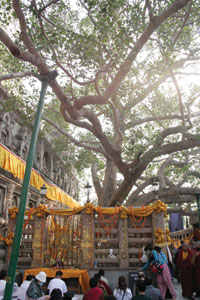The drought-ridden Indian state of Bihar is achingly poor, chronically dusty and famous for its corrupt politicians and gun-toting bandits. But Bihar has another, quite contrasting distinction, as the place where 2,500 years ago the thirty-five-year-old Guatama Buddha realized the innermost potential of the human mind under the Bodhi tree in the present-day city of Bodh Gaya. In fact, one of the city’s former names was Bodhimanda, meaning “the ground around the Bodhi tree.”
It seems fitting that the person whose teachings emphasize the non-duality of existence should be associated with a region so riddled with contrasts, paradoxes and contradictions. These are never more keenly underlined than during the huge Buddhist gatherings that take place here annually. For eleven days at the end of December, 2009, an estimated 30,000 monks, nuns and lay people from all Buddhist traditions came to Bodh Gaya to observe the 27th Kagyu Monlam. The Kagyu is one of the four schools of Tibetan Buddhism and the Monlam is a prayer festival. In Tibet, before the festival was banned by Chinese authorities, there was only one Monlam that was attended by practitioners from all four schools. But these days in India each school has its own Monlam. Originally attended mostly by Tibetan Buddhists, the Monlams have, over the years, grown into enormous non-denominational prayer gatherings for world peace.
The Kagyu Monlam attracts an unusually high number of Westerners and Buddhist practitioners from all over Asia. Today, the event is presided over by the 17th Karmapa of Tibet, the head of the Karma Kagyu, the largest sub-school of the Kagyu lineage. At the age of twenty-six, this rising spiritual leader is sturdy, dignified and charismatic. Many Tibetans see in him the potential to become a uniting force and an ambassador for the Tibet issue after the Dalai Lama. The young Karmapa has become a strong campaigner for the environment, and one of the most outspoken advocates for vegetarianism in the Tibetan Buddhist tradition. “This Earth is the stage for all human drama,” he said on the last day of the Monlam, while seated beneath the branches of the Bodhi tree. “Even bad people have to perform their deeds upon this stage. If we destroy it, where will we play out this drama?”
Buddhism was almost wiped out in India by the 13th century, due to a series of events and changing circumstances, the most dramatic of which was the invasion of Muslims from Afghanistan. The beginning of India’s Buddhist revival is attributed to the Sri Lankan pioneer, Anagarika Dharmapala, at the end of the 19th century. But since the 1960s, the Tibetan exiles, who preserved the dharma in cold storage for 1,000 years behind the Himalayan glaciers, have been contributing to the presence of Buddhism across the sub-continent.

The descendant of the original Bodhi tree where the Buddha experienced enlightenment 2,500 years ago.
Bodh Gaya has long been a mecca for Buddhist pilgrims, but it’s the Tibetans in particular who have been the inspiration behind these tibetimpressive communal events that are bringing together the world’s Buddhist traditions in common prayer. But however international the scene, the ground upon which it is played out is undeniably Indian. When the refuge prayer is chanted in Pali, the language in which the Buddhist Canon was originally transcribed, it seems to rise from the soil itself and carry with it the wisdom of centuries. Buddham saranam gacchami; Dhammam saranam gachami; Sangham saranam gachami.
Strings of colored electric lights and marigolds adorn the grounds of the magnificent 180 foot tall Mahabodhi temple that was built between the 5th and 6th century. Around the temple grounds, enlightenment is for sale with flashing light-up Buddhas, glow in the dark prayer beads and leaves that peddlers claim are from the Bodhi tree itself. The actual Bodhi tree (a descendant of the original) sits up against the temple’s western wall. It is generous and graceful with heart-shaped leaves. The site upon which it grows has been called ‘the navel of the world.’ After his enlightenment, it is said that the Buddha spent a whole week in front of the tree, just gazing at it. When the world is destroyed at the end of an eon, goes a Buddhist prophecy, the spot where the Bodhi tree grows will be the last place to disappear. When the world comes into existence again, it will be the first to reappear.
But whatever the myths, two and a half millennia after the Buddha sat here, this remarkable place seems to have the power to make you feel that you are seeing the world for the first time.
Rebecca Novick is the founding producer of The Tibet Connection radio program found online at thetibetconnection.org.
By Rebecca Novick
